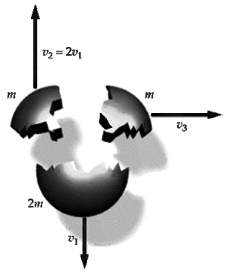(Multiple Choice) (1) Two pucks of mass m 1 and m 2 lie unconnected on a frictionless...
Question:
(Multiple Choice)
(1)
Two pucks of mass m1 and m2 lie unconnected on a frictionless table. A horizontal force F1 is exerted on m1 only. What is the magnitude of the acceleration of the center of mass of the pucks?
(a) F1/m1
(b) F1 /(m1 + m2)
(c) F1/m2
(d) (m1 + m2)F1/m1m2
(2)
The two pucks in Problem 16 are lying on a frictionless table and connected by a spring of force constant k. A horizontal force F1 is again exerted only on m1 along the spring away from m2. What is the magnitude of the acceleration of the center of mass?
(a) F1/m1
(b) F1/(m1 + m2)
(c) (F1 + k ∆x)/m1m2, where ∆x is the amount the spring is stretched
(d) (m1 + m2)F1/m1m2
(3) True or false:
(a) The momentum of a heavy object is greater than that of a light object at the same speed.
(b) The momentum of a system may be conserved even when mechanical energy is not.
(c) The velocity of the center of mass of a system equals the total momentum the system divided by its total mass.
(4)
Figure shows the behavior of a projectile just after it has broken up into three pieces. What was the speed of the projectile the instant before it broke up?
(a) v3
(b) v3/3
(c) v3/4
(d) 4v3
(e) (v1+v2+v3) / 4

(5)
True or False:
(a) In any perfectly inelastic collision, all the kinetic energy of the bodies is lost.
(b) In a head-on elastic collision, the relative speed of recession after the collision equals the relative speed of approach before the collision.
(c) Kinetic energy is conserved in an elastic collision.
(6)
A mass m1 traveling with a speed v makes a head-on elastic collision with a stationary mass m2. In which scenario will the energy imparted to m2 be greatest?
(a) m2 << m1
(b) m2 = m1
(c) m2 >> m1
(d) None of the above
(7)
The condition necessary for the conservation of momentum of a given system is that
(a) Energy is conserved.
(b) One object is at rest.
(c) No external force acts.
(d) Internal forces equal external forces.
(e) The net external force is zero.
Step by Step Answer:

Fundamentals of Ethics for Scientists and Engineers
ISBN: 978-0195134889
1st Edition
Authors: Edmund G. Seebauer, Robert L. Barry





